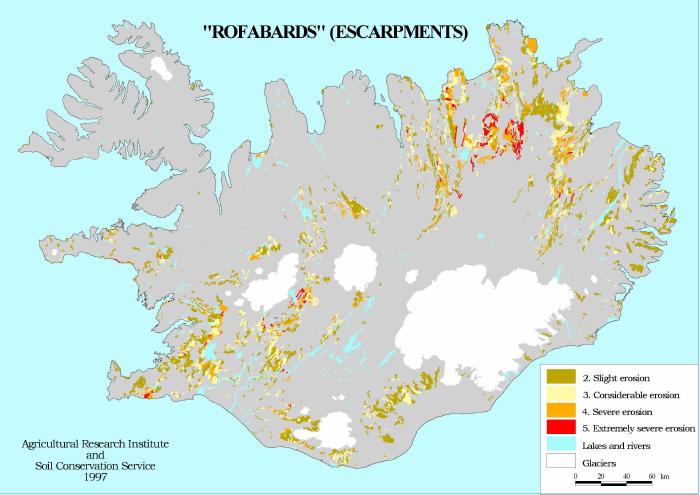| Erosion associated with loss of vegetated areas - overview The database can be used to show various kinds of information, such as where the erosion is associated with the loss of continuous vegetation cover, or the formation of new barren lands. This map shows where erosion is currently destroying vegetated ecosystems, which are priority areas for land reclamation in Iceland. Picture A few of the erosion forms that cause the loss of continuous vegetated land (Rofabards, Erosion spots, solifluction slopes, and landslides) are discussed in more detail. |
| Deserts- overview. Most of the severe erosion is associated with the deserts, particularly the sandy deserts. This maps shows the extent of the Icelandic deserts with erosion severity 3 (yellow), 4 (orange), and 5 (red). The deserts are closely linked to the active volcanic belt that runs from SW to NE Iceland, and the glacier margins. Picture Two desert types (Melar, Sandy deserts) are discussed in more detail below. See also: Arnalds, O. and J. Kimble 2001. Andisols of Deserts in Iceland. Soil Science Society of America Journal, 65:1778-1786. Arnalds, O., F.O. Gisladottir, and H. Sigurjonsson. 2001. Sandy deserts of Iceland: an overview. Jour. of Arid Environments 47: 359-371. |
| Rofabards As an example of how the database can be used to retrieve geomorphological information, "rofabards" (erosion escarpments) are taken as an example. As can be seen on the map, they are common in Iceland. Farmers throughout the country are currently making a good effort to halt erosion of this kind. The erosion escarpments are very prominent on the landscape where they occur. Picture Reference: O. Arnalds, 2000. The Icelandic "rofabard" soil erosion features. Earth Surface Processes and Landforms 25:17-28. |
 |
| Erosion spots Erosion spots are the most common erosion form in Iceland, but erosion is seldom severe where they dominate. They are often a direct result of the interaction between too much grazing and cryoturbation (and the formation of hummocks). Erosion spots on slopes and solifluction
Landslides
Melar (Lag gravel surfaces)
Sandy areas of Iceland |
Edited by Olafur Arnalds
and Einar Gretarsson Last updated on 29/3/2000 by EG |